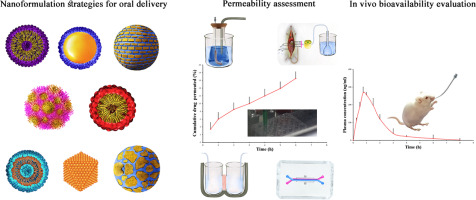当前位置:
X-MOL 学术
›
J. Control. Release
›
论文详情
Our official English website, www.x-mol.net, welcomes your feedback! (Note: you will need to create a separate account there.)
Nanoformulation strategies for improving intestinal permeability of drugs: A more precise look at permeability assessment methods and pharmacokinetic properties changes.
Journal of Controlled Release ( IF 10.8 ) Pub Date : 2020-02-27 , DOI: 10.1016/j.jconrel.2020.02.041 Delaram Babadi 1 , Simin Dadashzadeh 1 , Mahraz Osouli 1 , Maryam Sadat Daryabari 2 , Azadeh Haeri 3
Journal of Controlled Release ( IF 10.8 ) Pub Date : 2020-02-27 , DOI: 10.1016/j.jconrel.2020.02.041 Delaram Babadi 1 , Simin Dadashzadeh 1 , Mahraz Osouli 1 , Maryam Sadat Daryabari 2 , Azadeh Haeri 3
Affiliation

|
The therapeutic efficacy of orally administered drugs is often restricted by their inherent limited oral bioavailability. Low water solubility, limited permeability through the intestinal barrier, instability in harsh environment of the gastrointestinal (GI) tract and being substrate of the efflux pumps and the cytochrome P450 (CYP) can impair oral drug bioavailability resulting in erratic and variable plasma drug profile. As more drugs with low membrane permeability are developed, new interest is growing to enhance their intestinal permeability and bioavailability. A wide variety of nanosystems have been developed to improve drug transport and absorption. Sufficient evidence exists to suggest that nanoparticles are able to increase the transepithelial transport of drug molecules. However, key questions remained unanswered. What types of nanoparticles are more efficient? What are preclinical (or clinical) achievements of each type of nanoformulation in terms of pharmacokinetic (PK) parameters? Addressing this issue in this paper, we have reviewed the current literature regarding permeability enhancement, permeability assessment methods and changes in PK parameters following administration of various nanoformulations. Although permeability enhancement by various nanoformulations holds great promise for oral drug delivery, many challenges still need to be addressed before development of more clinically successful nanoproducts.
中文翻译:

改善药物肠道通透性的纳米制剂策略:更精确地观察通透性评估方法和药代动力学特性变化。
口服药物的治疗功效通常受其固有的口服生物利用度限制。低水溶性,通过肠屏障的有限通透性,在恶劣的胃肠道(GI)环境中不稳定以及作为外排泵的底物和细胞色素P450(CYP)会损害口服药物的生物利用度,从而导致血浆药物谱不稳定和变化。随着越来越多的具有低膜通透性的药物的开发,人们对提高其肠通透性和生物利用度的兴趣日益浓厚。已经开发了各种各样的纳米系统来改善药物的运输和吸收。存在足够的证据表明纳米颗粒能够增加药物分子的跨上皮运输。但是,关键问题仍未得到解答。哪种类型的纳米颗粒更有效?就药代动力学(PK)参数而言,每种类型的纳米制剂在临床上(或临床)取得了哪些成就?针对本文中的这个问题,我们回顾了有关渗透性增强,渗透性评估方法和施用各种纳米制剂后PK参数变化的最新文献。尽管通过各种纳米制剂提高通透性对于口服药物递送具有广阔的前景,但在开发临床上更成功的纳米产品之前,仍然需要解决许多挑战。我们已经审查了有关渗透性增强,渗透性评估方法和施用各种纳米制剂后PK参数变化的最新文献。尽管通过各种纳米制剂提高通透性对于口服药物递送具有广阔的前景,但是在开发临床上更成功的纳米产品之前,仍然需要解决许多挑战。我们已经审查了有关渗透性增强,渗透性评估方法和施用各种纳米制剂后PK参数变化的最新文献。尽管通过各种纳米制剂提高通透性对于口服药物递送具有广阔的前景,但在开发临床上更成功的纳米产品之前,仍然需要解决许多挑战。
更新日期:2020-02-27
中文翻译:

改善药物肠道通透性的纳米制剂策略:更精确地观察通透性评估方法和药代动力学特性变化。
口服药物的治疗功效通常受其固有的口服生物利用度限制。低水溶性,通过肠屏障的有限通透性,在恶劣的胃肠道(GI)环境中不稳定以及作为外排泵的底物和细胞色素P450(CYP)会损害口服药物的生物利用度,从而导致血浆药物谱不稳定和变化。随着越来越多的具有低膜通透性的药物的开发,人们对提高其肠通透性和生物利用度的兴趣日益浓厚。已经开发了各种各样的纳米系统来改善药物的运输和吸收。存在足够的证据表明纳米颗粒能够增加药物分子的跨上皮运输。但是,关键问题仍未得到解答。哪种类型的纳米颗粒更有效?就药代动力学(PK)参数而言,每种类型的纳米制剂在临床上(或临床)取得了哪些成就?针对本文中的这个问题,我们回顾了有关渗透性增强,渗透性评估方法和施用各种纳米制剂后PK参数变化的最新文献。尽管通过各种纳米制剂提高通透性对于口服药物递送具有广阔的前景,但在开发临床上更成功的纳米产品之前,仍然需要解决许多挑战。我们已经审查了有关渗透性增强,渗透性评估方法和施用各种纳米制剂后PK参数变化的最新文献。尽管通过各种纳米制剂提高通透性对于口服药物递送具有广阔的前景,但是在开发临床上更成功的纳米产品之前,仍然需要解决许多挑战。我们已经审查了有关渗透性增强,渗透性评估方法和施用各种纳米制剂后PK参数变化的最新文献。尽管通过各种纳米制剂提高通透性对于口服药物递送具有广阔的前景,但在开发临床上更成功的纳米产品之前,仍然需要解决许多挑战。

























 京公网安备 11010802027423号
京公网安备 11010802027423号